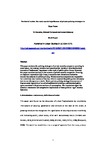Territorial Tactics: The Socio-spatial Significance of Private Policing Strategies in Cape Town
| dc.contributor.author | Paasche, TF | |
| dc.contributor.author | Yarwood, Richard | |
| dc.contributor.author | Sidaway, JD | |
| dc.date.accessioned | 2015-02-11T20:53:31Z | |
| dc.date.accessioned | 2015-02-11T21:03:56Z | |
| dc.date.accessioned | 2015-02-11T21:25:07Z | |
| dc.date.available | 2015-02-11T20:53:31Z | |
| dc.date.available | 2015-02-11T21:03:56Z | |
| dc.date.available | 2015-02-11T21:25:07Z | |
| dc.date.issued | 2014-06 | |
| dc.identifier.issn | 0042-0980 | |
| dc.identifier.issn | 1360-063X | |
| dc.identifier.uri | http://hdl.handle.net/10026.1/3239 | |
| dc.description.abstract |
<jats:p> This paper analyses the policing strategies of private security companies operating in urban space. An existing literature has considered the variety of ways that territory becomes of fundamental importance in the work of public police forces. However, this paper examines territory in the context of private security companies. Drawing on empirical research in Cape Town, it examines how demarcated territories become key subjects in private policing. Private security companies are responsible for a relatively small section of the city, while in contrast the public police ultimately have to see city space as a whole. Hence, private policing strategy becomes one of displacement, especially of so-called undesirables yielding a patchworked public space associated with private enclaves of consumption. The conclusions signal the historical resonances and comparative implications of these political–legal–security dynamics. </jats:p> | |
| dc.format.extent | 1559-1575 | |
| dc.language | en | |
| dc.language.iso | en | |
| dc.publisher | SAGE Publications | |
| dc.relation.replaces | http://hdl.handle.net/10026.1/3229 | |
| dc.relation.replaces | 10026.1/3229 | |
| dc.relation.replaces | http://hdl.handle.net/10026.1/3230 | |
| dc.relation.replaces | 10026.1/3230 | |
| dc.title | Territorial Tactics: The Socio-spatial Significance of Private Policing Strategies in Cape Town | |
| dc.type | journal-article | |
| dc.type | Journal Article | |
| plymouth.author-url | https://www.webofscience.com/api/gateway?GWVersion=2&SrcApp=PARTNER_APP&SrcAuth=LinksAMR&KeyUT=WOS:000335370900002&DestLinkType=FullRecord&DestApp=ALL_WOS&UsrCustomerID=11bb513d99f797142bcfeffcc58ea008 | |
| plymouth.issue | 8 | |
| plymouth.volume | 51 | |
| plymouth.publication-status | Published | |
| plymouth.journal | Urban Studies | |
| dc.identifier.doi | 10.1177/0042098013499084 | |
| plymouth.organisational-group | /Plymouth | |
| plymouth.organisational-group | /Plymouth/Faculty of Science and Engineering | |
| plymouth.organisational-group | /Plymouth/Faculty of Science and Engineering/School of Geography, Earth and Environmental Sciences | |
| plymouth.organisational-group | /Plymouth/Faculty of Science and Engineering/School of Geography, Earth and Environmental Sciences/SoGEES - Manual | |
| plymouth.organisational-group | /Plymouth/PS - Doctoral College | |
| plymouth.organisational-group | /Plymouth/REF 2021 Researchers by UoA | |
| plymouth.organisational-group | /Plymouth/REF 2021 Researchers by UoA/UoA14 Geography and Environmental Studies | |
| plymouth.organisational-group | /Plymouth/Users by role | |
| plymouth.organisational-group | /Plymouth/Users by role/Academics | |
| dc.identifier.eissn | 1360-063X | |
| dc.rights.embargoperiod | Not known | |
| rioxxterms.versionofrecord | 10.1177/0042098013499084 | |
| rioxxterms.licenseref.uri | http://www.rioxx.net/licenses/all-rights-reserved | |
| rioxxterms.type | Journal Article/Review |


